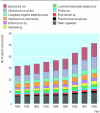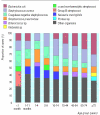Bacteraemia and antibiotic resistance of its pathogens reported in England and Wales between 1990 and 1998: trend analysis
- PMID: 10642227
- PMCID: PMC27266
- DOI: 10.1136/bmj.320.7229.213
Bacteraemia and antibiotic resistance of its pathogens reported in England and Wales between 1990 and 1998: trend analysis
Abstract
Objectives: Determination of causes, trends, and antibiotic resistance in reports of bacterial pathogens isolated from blood in England and Wales from 1990 to 1998.
Design: Description of bacterial isolates from blood, judged to be clinically significant by microbiology staff, reported to the Communicable Disease Surveillance Centre.
Setting: Microbiology laboratories in England and Wales.
Subjects: Patients yielding clinically significant isolates from blood.
Main outcome measures: Frequency and Poisson regression analyses for trend of reported causes of bacteraemia and proportions of antibiotic resistant isolates.
Results: There was an upward trend in total numbers of reports of bacteraemia. The five most cited organisms accounted for over 60% of reports each year. There was a substantial increase in the proportion of reports of Staphylococcus aureus resistant to methicillin, Streptococcus pneumoniae resistance to penicillin and erythromycin, and Enterococcus faecalis and Enterococcus faecium resistance to vancomycin. No increase was seen in resistance of Escherichia coli to gentamicin.
Conclusions: Reports from laboratories provide valuable information on trends and antibiotic resistance in bacteraemia and show a worrying increase in resistance to important antibiotics.
Figures



Comment in
-
The rise in bacterial resistance is partly because there have been no new classes of antibiotics since the 1960s.BMJ. 2000 Jan 22;320(7229):199-200. doi: 10.1136/bmj.320.7229.199. BMJ. 2000. PMID: 10642206 Free PMC article. No abstract available.
Similar articles
-
The changing epidemiology of bacteraemias in Europe: trends from the European Antimicrobial Resistance Surveillance System.Clin Microbiol Infect. 2013 Sep;19(9):860-8. doi: 10.1111/1469-0691.12028. Epub 2012 Oct 8. Clin Microbiol Infect. 2013. PMID: 23039210
-
[Antibiotic resistance of Gram-positive cocci isolated in 2008].Bacteriol Virusol Parazitol Epidemiol. 2010 Apr-Jun;55(2):83-92. Bacteriol Virusol Parazitol Epidemiol. 2010. PMID: 21553473 Romanian.
-
Emergence of methicillin resistant Staphylococcus aureus (MRSA) bacteraemia among children in England and Wales, 1990-2001.Arch Dis Child. 2004 Apr;89(4):378-9. doi: 10.1136/adc.2003.028712. Arch Dis Child. 2004. PMID: 15033852 Free PMC article.
-
Resistant gram-positive organisms.Ann Emerg Med. 1994 Sep;24(3):462-4. doi: 10.1016/s0196-0644(94)70185-7. Ann Emerg Med. 1994. PMID: 8080144 Review.
-
[Treatment of bacterial endocarditis].Wiad Lek. 1982 Nov 1;35(19-20):1257-64. Wiad Lek. 1982. PMID: 6819721 Review. Polish. No abstract available.
Cited by
-
Risk factors for hospital-acquired methicillin-resistant Staphylococcus aureus bacteraemia: a case-control study.Epidemiol Infect. 2006 Dec;134(6):1167-73. doi: 10.1017/S0950268806006327. Epub 2006 Apr 20. Epidemiol Infect. 2006. PMID: 16623990 Free PMC article. Clinical Trial.
-
Prevalence of antibiotic resistance in Escherichia coli: overview of geographical, temporal, and methodological variations.Eur J Clin Microbiol Infect Dis. 2007 Feb;26(2):83-90. doi: 10.1007/s10096-006-0248-2. Eur J Clin Microbiol Infect Dis. 2007. PMID: 17235554
-
Effects of antibiotics on nosocomial epidemiology of vancomycin-resistant enterococci.Antimicrob Agents Chemother. 2002 Jun;46(6):1619-28. doi: 10.1128/AAC.46.6.1619-1628.2002. Antimicrob Agents Chemother. 2002. PMID: 12019066 Free PMC article. Review. No abstract available.
-
Trends and outcome of nosocomial and community-acquired bloodstream infections due to Staphylococcus aureus in Finland, 1995-2001.Eur J Clin Microbiol Infect Dis. 2005 Jun;24(6):399-404. doi: 10.1007/s10096-005-1345-3. Eur J Clin Microbiol Infect Dis. 2005. PMID: 15931453
-
Antimicrobial-resistant invasive Escherichia coli, Spain.Emerg Infect Dis. 2005 Apr;11(4):546-53. doi: 10.3201/eid1104.040699. Emerg Infect Dis. 2005. PMID: 15829192 Free PMC article.
References
-
- Young LS. Sepsis syndrome. In: Mandell GL, Bennett JE, Dolin R, editors. Principles and practice of infectious diseases. New York: Churchill Livingstone; 1995. pp. 690–705.
-
- House of Lords Select Committee on Science and Technology. Resistance to antibiotics and other antimicrobial agents. London: Stationery Office; 1998.
-
- Standing Medical Advisory Committee: Subgroup on Antimicrobial Resistance. The path of least resistance. London: Department of Health; 1998.
Publication types
MeSH terms
LinkOut - more resources
Full Text Sources
Medical
